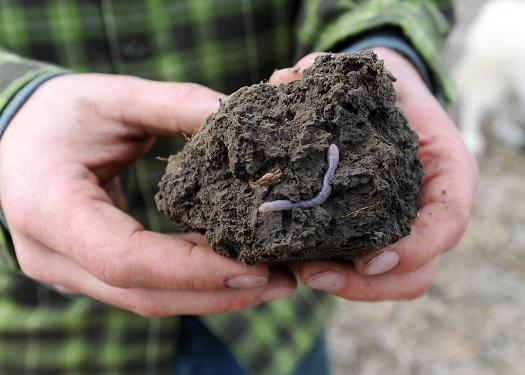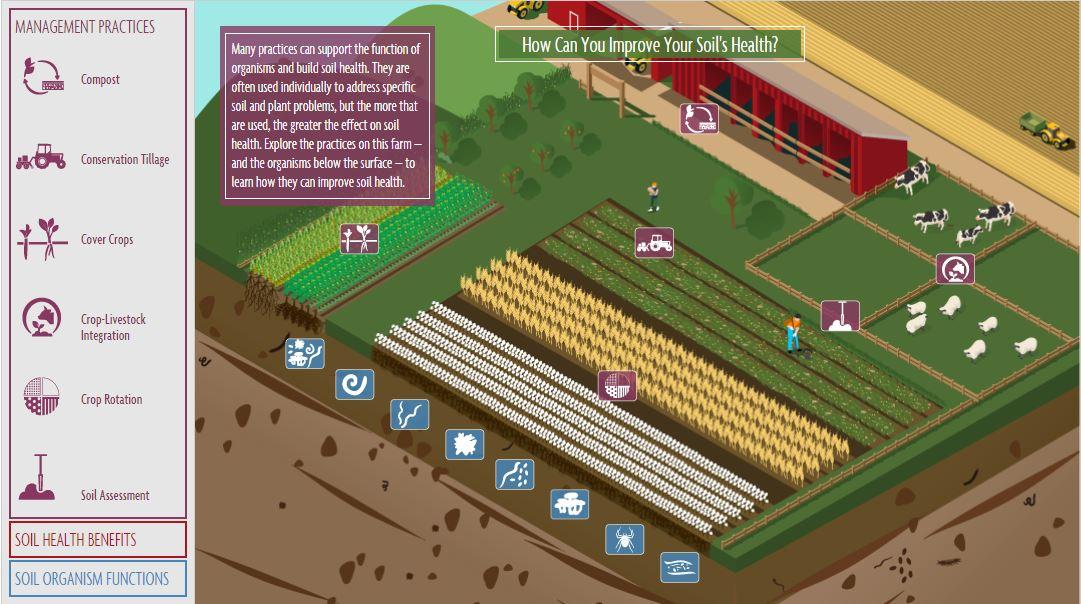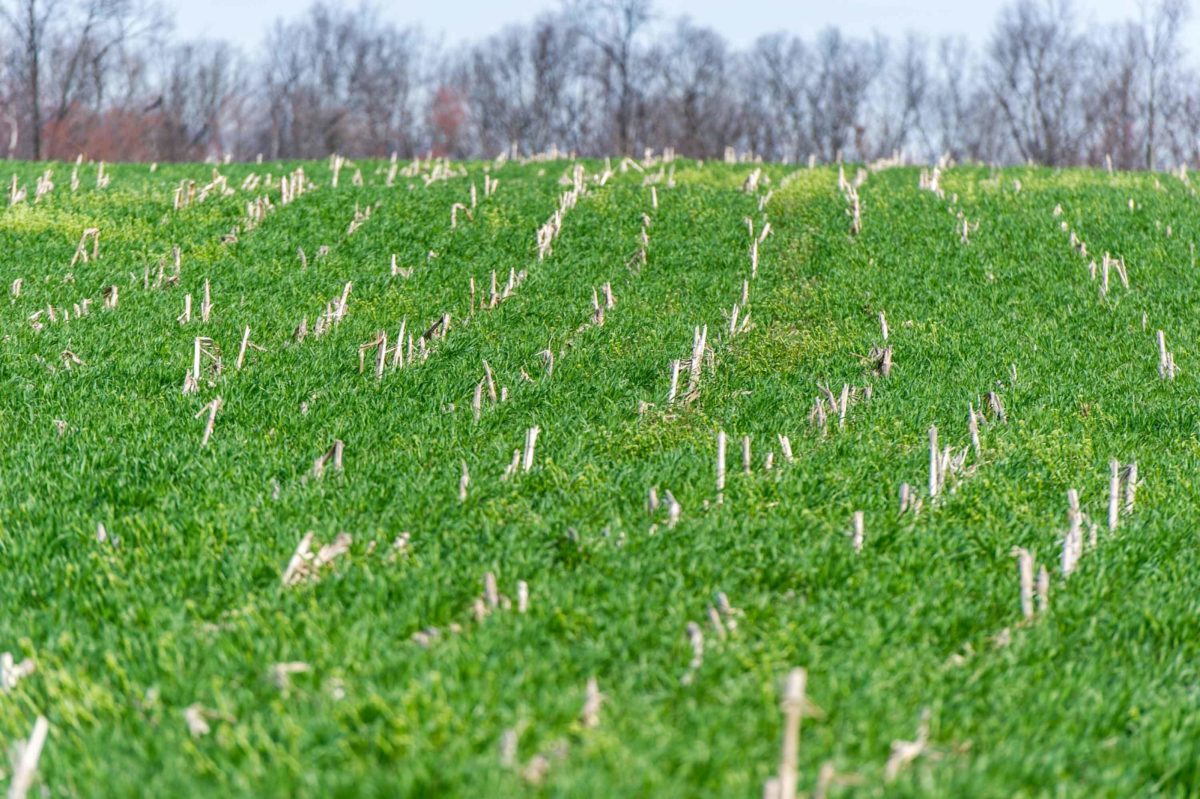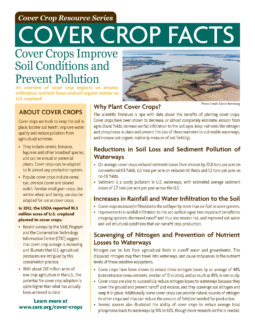An overview of how cover crops affect soil invertebrates and of the benefits they provide.

Download this fact sheet (PDF). This fact sheet is part of the Ecosystem Services from Cover Crops fact sheet series.
What are Soil Invertebrates?
Healthy soil is home to a great diversity of soil invertebrates. Over 1,000 different species may be found in a single cubic meter of soil. Soil invertebrates can be divided into groups based on taxonomy or size, but in agricultural settings they are best grouped by their function in the soil ecosystem.1
- Ecosystem engineers include earthworms, ants and termites that have a disproportionate effect on soil ecosystems due to their ability to move and restructure soil. They create tunnels, galleries and middens (dunghills) that can dramatically alter soil structure and hydrology. This activity creates habitat for other members of the soil ecosystem. For example, earthworms transport plant material beneath the surface where it can be consumed by other invertebrates and microbes. Earthworm fecal casts and middens are also hot spots for biological activity.
- Litter transformers include sowbugs, springtails, insect larvae, millipedes and other invertebrates that shred and consume plant litter and roots, while producing nutrient-rich fecal matter. The smallest invertebrates, as well as microbes, feed on both the shredded plant matter and fecal matter, eventually transforming them into stable organic matter, or humus.
- Predators range in size from miniscule nematodes and springtails to larger mites, millipedes and beetles. Some predators consume other invertebrates, while others prey upon bacteria, fungi and other microbes.
How Do Cover Crops Help Soil Invertebrates?
Whether they feed on plant residues and living roots or microorganisms, all soil invertebrates ultimately rely on plants. Modern cropping systems are usually disturbed both intensely and frequently, leaving soil invertebrates with no living roots and little residue for parts of the year. Living cover crops feed and support soil invertebrates when cash crops are not growing. Cover crops then continue to support invertebrates as the residue breaks down once a cash crop is growing.
- Night crawlers and millipedes that prefer plant residue on the surface have a much greater food supply with cover crops present. Adding a white clover cover into continuous wheat doubled earthworm biomass after three years.2 A cereal rye cover crop increased earthworm populations by 175 percent in a continuous corn system.3
- Living roots are essential for some soil invertebrates. Mites, nematodes and springtails feed on bacteria and fungi that survive on root exudates.
Why Should We Care About Soil Invertebrates?
A diverse and abundant community of soil invertebrates makes for a healthy, resilient and productive soil. Invertebrates provide ecosystem services by affecting the physical, chemical and biological aspects of soil health.
Nutrient Cycling
- Earthworms and shredders like millipedes mineralize some nutrients by digesting plant residue. They also make residue accessible to microbes and smaller decomposers that can’t shred or finish mineralizing nutrients.
- Nematodes and other predatory invertebrates prevent nitrogen from being tied up in bacteria or fungi by consuming them and excreting the excess nitrogen in a plant-available form.
- Soil invertebrates increase soil organic matter by turning plant residues into stable forms. A great deal of soil organic matter is either living soil invertebrates or their feces and dead bodies. Stable organic matter also sequesters carbon.

What is Soil Health?
Soil health plays an essential role in raising healthy, productive crops and livestock. With this interactive soil health infographic, learn how practices such as cover crops, no-till, crop rotation and the integration of livestock work in concert to improve soil health.
Water Infiltration and Water-Holding Capacity
- Some types of earthworms, like night crawlers, create deep vertical channels that allow water to infiltrate quickly. These chambers allow for increased water storage.
- Smaller invertebrates increase soil aggregation, which prevents soil sealing and increases both infiltration and water-holding capacity.
- Greater water infiltration and holding capacity reduce erosion and can improve water quality.
Plant Health and Pest Protection
- Plant roots grow into earthworm-dug channels, allowing them to more easily access water and nutrients deeper underground.
- A diverse community of soil invertebrates can suppress pathogens and belowground pests.
Managing Cover Crops for Soil Invertebrates
Considering how management practices affect soil invertebrates can help build soil health. Here are some tips for maintaining a thriving soil ecosystem:
- Establish cover crops as early as possible by flying on seed, using an interseeder, or fitting early maturing crops or varieties into the rotation. The more biomass produced, the more energy available for soil invertebrates.
- Better late than never. Cover crops planted late in the fall may not look impressive above ground, but the living roots can feed and protect invertebrates over winter while providing a boost in the spring.
- Use cover crop mixes. A diversity of food sources leads to a more diverse soil ecosystem. Earthworms generally prefer plants with lower C:N ratios, making a cereal rye monocrop a less-than-ideal food source. Including a legume will benefit earthworms.
- Minimize tillage. Tillage can injure or kill soil invertebrates, as well as disrupt their habitat. Earthworm channels and chambers are destroyed, and surface residue is incorporated into the soil where some invertebrates cannot access it. Earthworm abundance can be two to nine times greater in no-till systems than in conventional tillage systems.4
About Cover Crops

Cover crops are tools to keep the soil in place, bolster soil health, improve water quality and reduce pollution from gricultural activities.
- They include cereals, brassicas, legumes and other broadleaf species, and can be annual or perennial plants. Cover crops can be adapted to fit almost any production system.
- Popular cover crops include cereal rye, crimson clover and oilseed radish. Familiar small grain crops, like winter wheat and barley, can also be adapted for use as cover crops.
1 Lavelle, P. 1996. Diversity of Soil Fauna and Ecosystem Function. Biology International 33: 3–16.
2 Schmidt, O., and J.P. Curry. 2001. Population dynamics of earthworms (Lumbricidae) and their role in nitrogen turnover in wheat and wheat-clover cropping systems. Pedobiologia 45: 174–187.
3 Reeleder, R.D., J.J. Miller, B.R. Ball Coelho, and R.C. Roy. 2006. Impacts of tillage, cover crop, and nitrogen on populations of earthworms, microarthropods, and soil fungi in a cultivated fragile soil. Applied Soil Ecology 33: 243–257.
4 Chan, K.Y. 2000. An overview of some tillage impacts on earthworm population abundance and diversity - Implications for functioning in soils. Soil and Tillage Research 57: 179–191.
